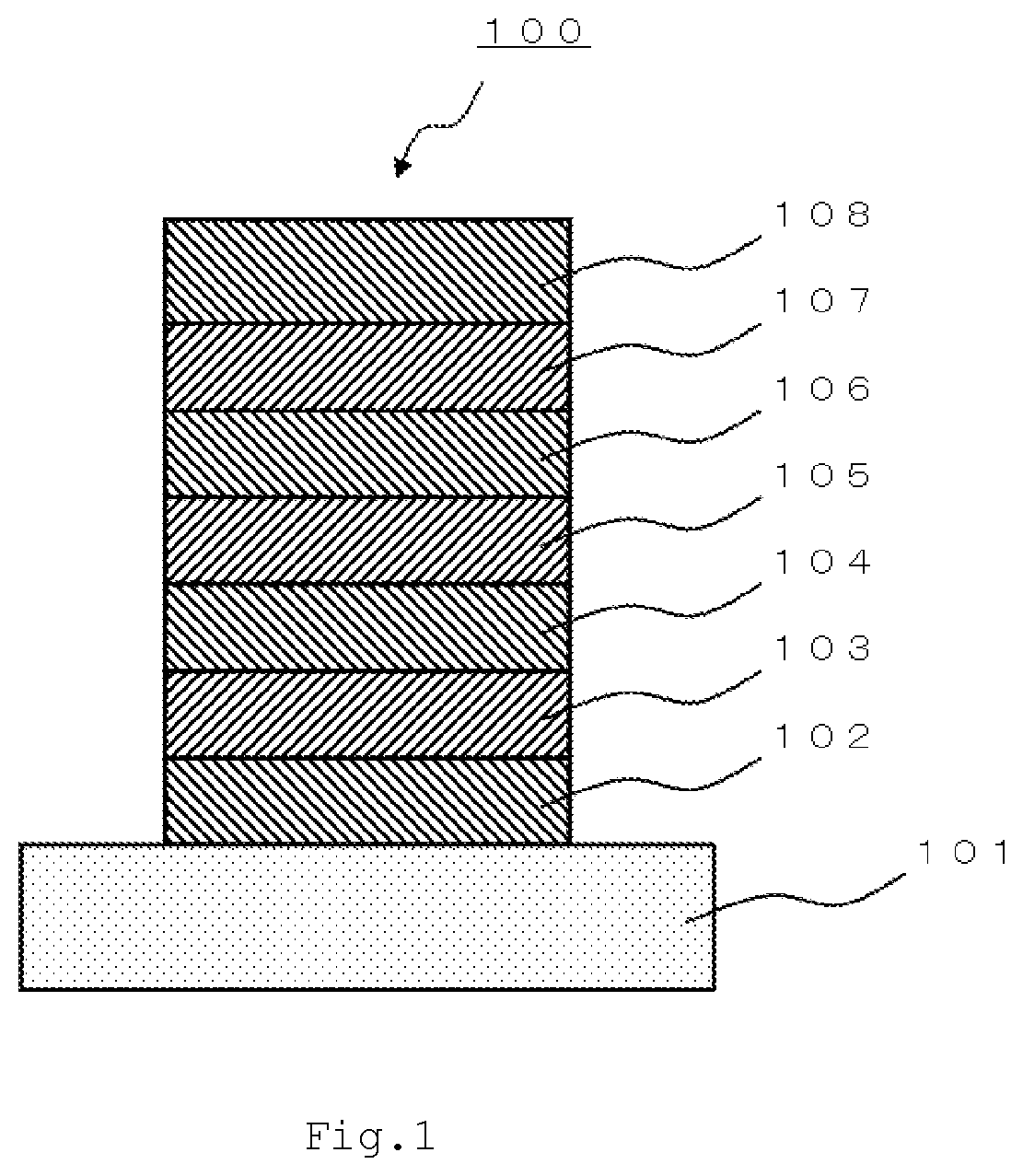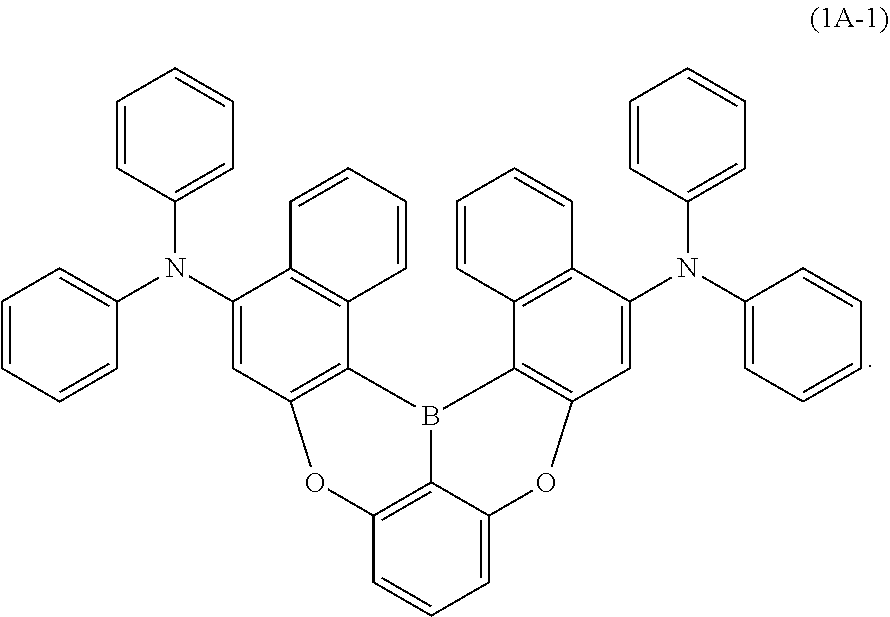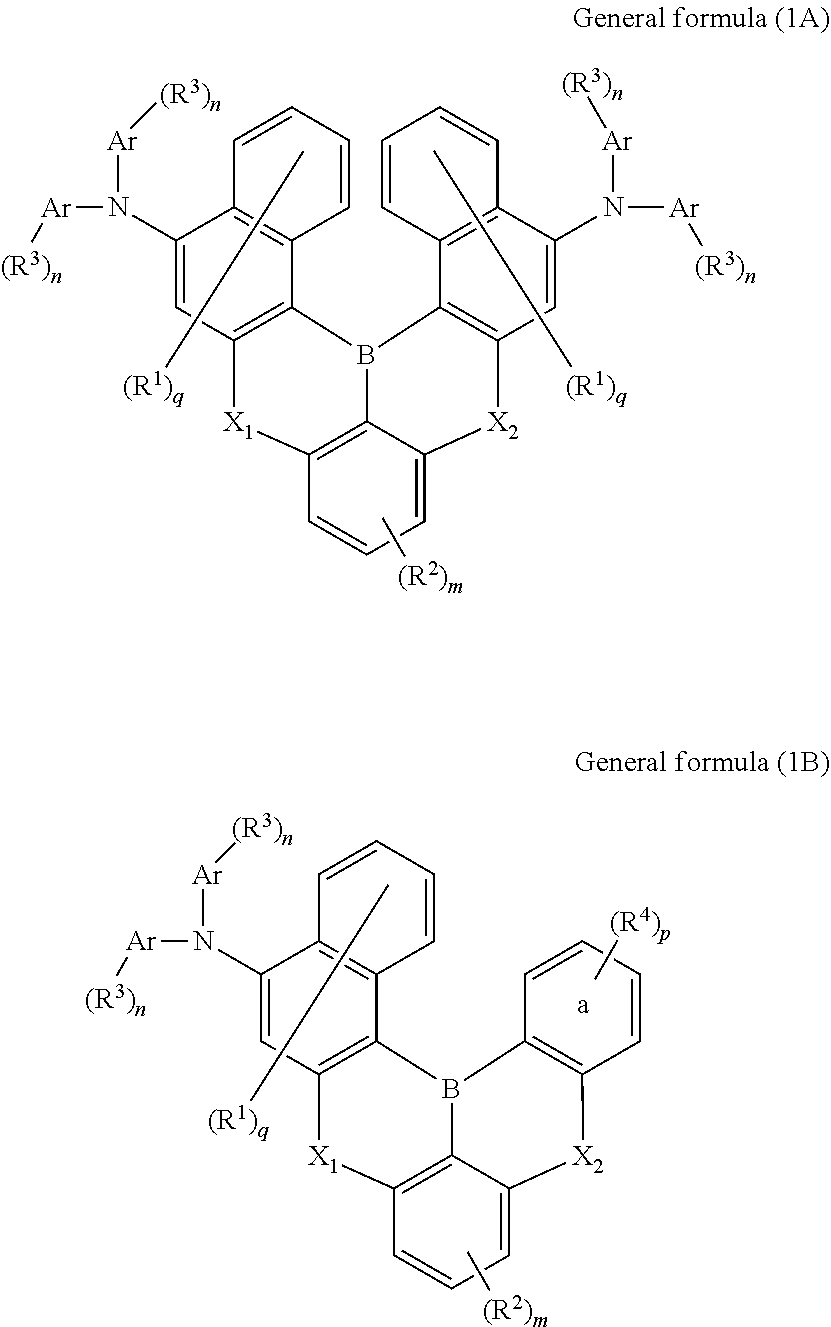Polycyclic aromatic amino compound
a polycyclic aromatic and amino compound technology, applied in the field of polycyclic aromatic amino compound and organic electroluminescent element, can solve the problems of insufficient lifetime of existing aromatic rings as host materials, insufficient redox stability of aromatic rings having small conjugated systems, and inability to describe a method for manufacturing other materials, etc., to achieve excellent organic el element, reduce homo-luminescence gap, and high triplet excitation energy
- Summary
- Abstract
- Description
- Claims
- Application Information
AI Technical Summary
Benefits of technology
Problems solved by technology
Method used
Image
Examples
examples
[0236]Hereinafter, the present invention will be described more specifically by way of Examples, but the present invention is not limited thereto. First, Synthesis Examples of the polycyclic aromatic amino compound will be described below.
Synthesis Example (1)
Synthesis of compound of formula (1A-1): N5,N5,N13,N13-tetraphenyl-7,11-dioxa-17c-boraphenanthro[2,3,4-no]tetraphen-5,13-diamine
[0237]
Synthesis of 4-(diphenylamino) naphthalen-2-ol
[0238]In a nitrogen atmosphere, a flask containing diphenylamine (22.3 g), 4-bromonaphthalen-2-ol (28.0 g), Pd-132 (Johnsen Massey) (0.9 g), NaOtBu (30.0 g), and toluene (252 ml) was heated and refluxed for four hours. The reaction liquid was cooled to room temperature. Thereafter, water and ethyl acetate were added thereto, and the resulting mixture was subjected to liquid separation. Furthermore, purification was performed with a silica gel column (eluent: toluene) to obtain 35 g (yield: 89.5%) of 4-(diphenylamino) naphthalen-2-ol as an intermediate...
synthesis example (
4)
Synthesis of compound (1B-92): 7-([1,1′-biphenyl]-4-yl)-(N,N,10-triphenyl-7H-3-oxa-7-aza-11b-boraphenanthro[3,2,1-no]tetraphen-1-amine
[0257]
Synthesis of 3-(3-bromo-2-chlorophenoxy)-N,N-diphenylnaphthalen-1-amine
[0258]In a nitrogen atmosphere, a flask containing 4-(diphenylamino) naphthalen-2-ol (32.0 g), 1-bromo-2-chloro-3-fluorobenzene (23.7 g), potassium carbonate (35.5 g), and 1-methyl-2-pyrrolidone (160 ml) was heated and stirred at a reflux temperature for three hours. After the reaction stopped, the reaction liquid was cooled to room temperature, and a precipitate precipitated by adding water thereto was collected by suction filtration. The obtained precipitate was washed with water and then with methanol and then purified with a silica gel column (eluent: toluene / heptane=1 / 5 (volume ratio)) to obtain 46.5 g (yield: 90.3%) of 3-(3-bromo-2-chlorophenoxy)-N,N-diphenylnaphthalen-1-amine as an intermediate compound.
Synthesis of 3-(2-chloro-3-(di([1,1′-biphenyl]-4-yl) amino) phen...
example 1
Element Using Compound (1A-173) as Dopant of Light Emitting Layer
[0279]A glass substrate (manufactured by Opto Science, Inc.) having a size of 26 mm×28 mm×0.7 mm, obtained by forming a film of ITO having a thickness of 180 nm by sputtering, and polishing the ITO film to 150 nm, was used as a transparent supporting substrate. This transparent supporting substrate was fixed to a substrate holder of a commercially available vapor deposition apparatus (manufactured by Choshu Industry). Tantalum vapor deposition crucibles containing HI, HAT-CN, HT, BH1, compound (1A-173) of the present invention, ET5, and ET6, respectively, and aluminum nitride vapor deposition crucibles containing Liq, magnesium, and silver, respectively were attached thereto.
[0280]Layers described below were formed sequentially on the ITO film of the transparent supporting substrate. A vacuum chamber was depressurized to 2.0×10−4 Pa. First, HI was heated and vapor-deposited so as to obtain a film thickness of 40 nm. Su...
PUM
| Property | Measurement | Unit |
|---|---|---|
| T1 energy | aaaaa | aaaaa |
| thickness | aaaaa | aaaaa |
| thickness | aaaaa | aaaaa |
Abstract
Description
Claims
Application Information
 Login to View More
Login to View More - R&D
- Intellectual Property
- Life Sciences
- Materials
- Tech Scout
- Unparalleled Data Quality
- Higher Quality Content
- 60% Fewer Hallucinations
Browse by: Latest US Patents, China's latest patents, Technical Efficacy Thesaurus, Application Domain, Technology Topic, Popular Technical Reports.
© 2025 PatSnap. All rights reserved.Legal|Privacy policy|Modern Slavery Act Transparency Statement|Sitemap|About US| Contact US: help@patsnap.com



